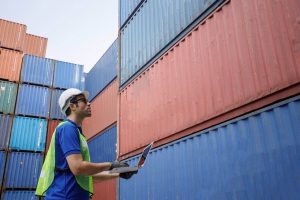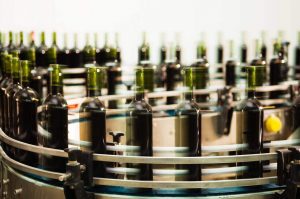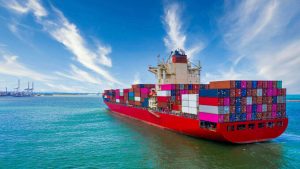Supplies — “… only as strong as the weakest link…”

A supply chain means just what it says. For deliveries to arrive at the retail outlet, each link in the chain from the producer to the exporter, to the carrier, to the importer and to the distributor must play its part or the whole operation fails.
This has never been more clearly demonstrated than at present when hefty delays in supplies to importers, distributors and wholesalers have become a post-Covid feature of beverage logistics.
Perfect Storm
Globally, supplies are experiencing something of a ‘perfect storm’ as shortages of both raw materials and staff generate cost hikes and delays – all of which have hit importing (and exporting) companies in one veritable Tsunami of rising costs and shortages.
And while the on-trade and off-trade here have yet to experience the full force of these delays, “It’s coming down the line” promised one importer, “Every supplier’s talking about this at the moment. Supply companies are beginning to say they can’t get you this and that but even the alternatives are beginning to run out as well.”
One importer could only get 30% of the volume he wanted originally aboard a containership.
Shortages
A shortage of aluminium caused by rising energy costs for smelting has hit canned beer suppliers and shows no sign of abating.
A shortage of glass bottles has similarly affected bottled beer supplies.

Initially, Covid restrictions meant fewer shipping port staff, fewer warehouse staff and truckdrivers.
Two years of living with – and being absent from work because of – Covid-19 has meant that suppliers and distributers have not been able to run their businesses at full scale. Initially, Covid restrictions meant fewer shipping port staff, fewer warehouse staff and truckdrivers etc. This state of affairs fractured out so that wineries had huge problems in getting packaging and glass bottles etc.
Chilean wineries, for example, have simply not been able to run at full capacity. At the turn of the year, one major wine bottling business in the UK witnessed five bottling lines struck down to just two.
Skeleton staffing issues
Like many other parts of the supply chain, shipping companies were still working off skeleton staff because of Covid so a backlog of deliveries developed.
At the height of the Covid crisis PPE deliveries to various parts of the world meant that containers found themselves in the wrong part of the globe at the wrong time.
Covid’s putting vessels in the wrong places has repercussions that go on to this day as the imbalance created will take a considerable time to work through the system.
And while it had been expected that some sort of balance would return to the trade later this year, that was before the Russian invasion of Ukraine which is now having a severe impact on fuel costs.
Prior to Covid, a Deep Sea order might take 8-12 weeks to arrive but this has now stretched out to six months although Lanchester Wines’ Business Manager for Ireland Michael O’Brien believes that this is beginning to return to more normal delivery times now with the delay’s length being associated more with the country concerned.
Cost increases
Costs are a largely irreversible fact of life in the supply business and these have shot up 20% on average and by more in some sub-categories of supply.
In a global shortage of transportation, supply and demand have become something of a cartel. All shipping companies have put up their prices and naturally they’re giving the best payers priority.
This has led to delays and missed shipment dates for the rest, thus supply companies here find themselves looking at longer lead times as a result, with the practice of ‘just-in-time’ taking a back seat to higher-paying priorities.
Paying priorities
In any shortage, those who pay the most get priority – a bit like being an Amazon Prime customer. Global spirits sales did particularly well during Lockdown and so they can afford to book priority deliveries over the rest of the beverage world as can perishables or ‘reefer traffic’ such as fruits where the freight rate would be a multiple of standard container freight.
Shipments from South America used cost around €1,800 per container, a price that had been stable for the past 10 years or so. This has now shot up to €6,000.
So the overall cost of getting wine from Chile, for example, has more than trebled over the last nine months.
Gerry Kiernan is National Sales Manager for A Hartrodt Ireland, a German-owned freight forwarder.
He feels that we may have gone through the worst of the disruption, “…but it’s difficult to say now with Ukraine. I know there are going to be knock-on effects on fuel costs”.
On the other hand, he points out that the ships that used to go into ports like Odessa and St Petersburg can be redeployed now to other markets where they’re needed. This might relieve the situation somewhat.
Supply logistics
There are about five major players in global shipping today where there would have been at least 15 players in the market 20 years ago, so suppliers and importers have to book in with them well in advance to schedule space oncontainerships or supertankers.
But there’s many-a slip ‘twixt cup and lip before supplies can get aboard in the first place.
Take raw materials and packaging or transportation from vineyard to vessel as an example.
Getting supplies out from the winery requires a high degree of coordination for all the disparate elements of a wine beverage product to come together in time to meet that scheduled delivery truck.
Wineries need to be able to coordinate the label-maker with correct labelling information, with the glass supplier for the chosen type of glass, with the bottle supplier for their choice of bottle shape and with the cardboard box supplier for further packaging – and all have to be in place when the bottling plant is ready to run a production batch.

Getting supplies out from the winery requires a high degree of coordination for all the disparate elements of a wine beverage product to come together in time to meet that scheduled delivery truck.
If one part of that link fails then no bottling takes place and scheduled transportation and subsequent delivery dates are missed.
Wine shortages
Other reasons have also come into play in generating some wine shortages.
A massive shortage of New Zealand Sauvignon Blanc has arisen following its increase in popularity in the US which has been buying it at a premium. Add to this the 2021 vintage shortfall in NZ and one can begin to understand why NZ Sauv blanc is in short supply here.
In Europe, a bad Spring due to frost etc has led to wine price increases and this, mixed with shipping costs and the rising cost of raw materials, makes the supply of product unsustainable, thus the ‘perfect storm’ analogy seems apt.
For companies like Lanchester Wines, the shortage of delivery drivers in the UK has been a real problem.
“Hauliers say they’re putting up prices due to the rising cost of fuel,” says Michael.
All of this has led to price increases elsewhere, which is driving prices upwards for everyone. Tellingly, these increases are not being argued with by the purchasers.
In a letter to domestic distributors at the height of Covid Greencroft Bottling – part of the Lanchester Group – stated, “Due to the national increasing rate of infection from the recent Covid strain, it’s with regret that we need to inform you that in the immediate short term, we’re having to unwillingly scale back our weekly production capability. The supply into us of both bulk wine and materials has been significantly reduced. With the staffing levels across our own business having also been depleted by approximately 20%.
“Unfortunately, this has coincided with an unprecedented amount of bulk arriving Port side most of which has been delayed weeks or months. As it stands, there’s currently six million litres at the various quays to contend with. This is despite the long-term forecasts indicating this would and should have all arrived pre-Xmas.
“To put this into context, our production output in November and December last year was four million litres less than that of 2020, with 79 failed or cancelled deliveries, adding an additional 1.9 million litres to lost capacity. Essentially, all of the six million litres now at Port, should have arrived and packaged last year.
“Whilst we understand the urgency of this, the circumstances we find ourselves in are very much out of all of our control.
“We’re working through this as best we can, but during this time, we’d appreciate both your patience and understanding. If possible, we’d ask that you start dialogue with both your own freight forwarder(s) and Customers please in order for them to put in place whatever contingency plans they need to.
“Our aim will be to review this on a weekly basis, keeping you updated whenever possible. In the hope that this is limited to as short-a-time as possible.”
As a recent report from Investment Monitor explained, “It isn’t simply manufacture and ship for as low-a-cost as possible any more”.
Security of supply has become paramount with the result that shipping costs have risen dramatically, it pointed out.
China Ocean Shipping Company’s prices for nine months in 2021 went up from $15,590 to $33,317, a 112% increase.
And COSCO wasn’t the worst example. While Wan Hai shipping’s prices went up by 204% in this time, shippers like Evergreen put a 144% price increase in place and Hapag-Lloyd instituted a 58% price increase while the Maersk Group put up prices by 63%.
All these shipping companies reported net profits of at least three figure percentages – most enjoyed net profits of four figure percentages and in the case of one shipping company a five figure percentage.
Lisa Anderson, President of supply chain consultancy LMA Consulting Group, told Investment Monitor, “[The rocketing container costs are] increasing the prices of goods because companies can’t just absorb these prices and they are passing them on. It’s causing this inflation that will continue as long as shipping prices are high.”
And just when that light at the end of the tunnel hoved into view following Covid, it turns out to have been an out-of-control hurtling freight train in the form of Vladimir Putin.
Further disruption to world trade will be inevitable as fuel costs and charges rise, pushing up shipping costs still further… and pushing up prices at bar counters inevitably too.
Supply-Chain Vulnerability Index

The EU was by far the most exposed to supply chain disruptions from February 2020 until August 2020 according to the Statista Supply Chain Index but GlobalData’s Supply Chain Vulnerability Index puts the US and UK top and second-top for supply chain vulnerability. Austria, France and Russia fill-out the others in the vulnerability Top Five.
Ironically Statista rated Ireland’s supply chain one of the most secure according to GlobalData which put Germany as being the most secure along with China, South Korea and the Netherlands.
But few can have failed to notice the swingeing increase in container costs as a result of a number of factors including Covid and geopolitical tensions, with the cost of a 40ft container increasing from $1,331 on average at the end of February 2020 to a peak of $11,109 by mid-September 2021. But experts are divided on whether this will continue throughout 2022.
In the meantime according to Investment Monitor, “The highly reported labour shortage, particularly of truck drivers, is a problem that is infecting not just shipping but the entire supply chain”.








